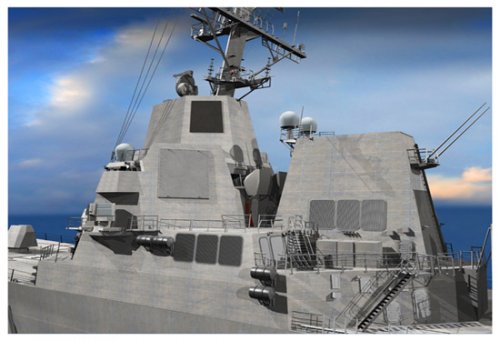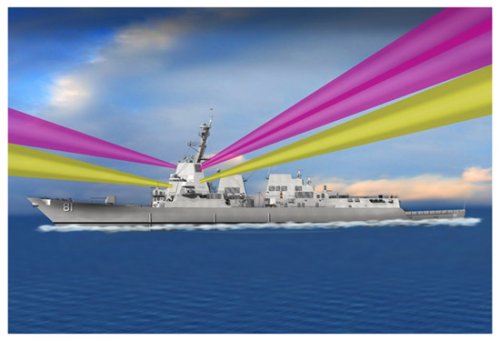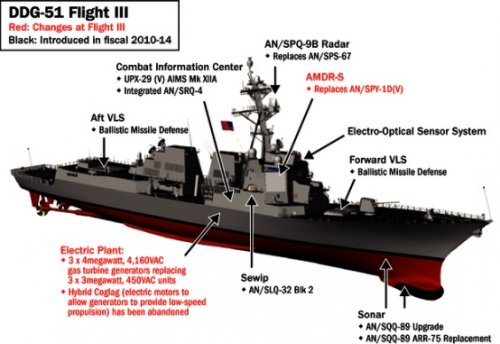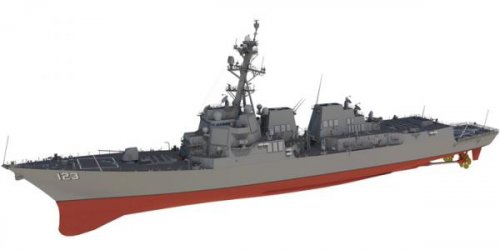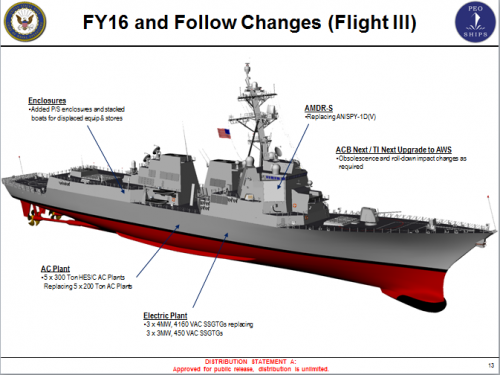- Joined
- 9 October 2009
- Messages
- 21,147
- Reaction score
- 12,249
I'm creating this topic to bring together any information that becomes available on AMDR, especially since it increasingly seems that the class that was originally intended to be equiped with the (downgraded, supposely lower cost version) system, the Burke Flight III is a developmental dead end that may not even make it off the drawning board, and a clean sheet design (cruiser? - quite likely to be nuclear powered) will have to be subsituted, assuming of course, that with the failure of Flight III, AMDR doesn't get cancelled like Typhoon was ultimately.
Tuesday, April 5, 2011
Something Isn't Quite Right With AMDR
If you haven't seen it, I encourage you to watch the video of the testimony given by Eric Labs and Ronald O'Rourke in front of the House Armed Services Committee Seapower and Projection Forces Subcommittee. There is an exchange in the middle of the hearing where the DDG-51 Flight IIIs and AMDR is discussed, and once again Ronald O'Rourke discusses the Cobra Judy program. This isn't the first time Ronald O'Rourke has brought up Cobra Judy in testimony, but it is important to note.
Below are the relevant discussion materials from the printed testimony. First Eric Labs of CBO to set the stage.
DDG-51 Flight III. The Navy’s strategy to meet combatant commanders’ demand for the increased capabilities of ballistic missile defense ships—as well as to replace Ticonderoga class cruisers when they retire in the 2020s—is to modify the DDG-51 destroyer substantially, creating a Flight III configuration. That configuration would incorporate the new Air and Missile Defense Radar (AMDR), now under development, which is larger and more powerful than the radars on earlier DDG-51s. Adding the AMDR would require increasing the amount of power and cooling available on a Flight III ship in order to operate the radar effectively.25 Those changes, and associated increases in the ship’s displacement, would make a DDG-51 Flight III at least $500 million, or about 30 percent, more expensive than a new Flight IIA, by CBO’s estimate.
However, there appears to be some question as to whether the hull of the DDG-51 will be able to accommodate the changes envisioned for Flight III. In particular, if the AMDR proved too large to fit inside the deckhouse (the main superstructure above the hull) of a DDG-51 without raising the ship’s center of gravity and destabilizing it, the Navy would need to lengthen the ship, further increasing its displacement and cost substantially. Overall, the Navy plans to buy 24 DDG-51 Flight III ships between 2016 and 2031. If the Navy does not need to lengthen the DDG-51’s hull, those Flight IIIs will cost an average of $2.4 billion, CBO estimates, compared with the Navy’s estimate of $2.0 billion.
Note, the $2.4 billion is for a DDG-51 Flight III destroyer where the hull is not increased to accommodate the AMDR. The Navy is estimating the cost at $2.0 billion, which I think is an optimistic figure even with a bulk purchase.
Below is the testimony by Ronald O'Rourke of CRS.
DDG-51 Program
Other risks for the DDG-51 program include cost and schedule risks associated with restarting Flight IIA DDG-51 production, technical risks associated with developing the Air and Missile Defense Radar (AMDR) and other elements of the combat system for the Flight III DDG-51, and the previously mentioned risk of construction cost growth on Flight III DDG-51s. Some observers are concerned about the Navy’s ability to develop the AMDR on the schedule needed to begin procuring the first Flight III DDG-51 in FY2016 as currently planned. The Navy could manage this risk by deferring the procurement of the first Flight III ship to FY2017 or later, if necessary, and instead continue procuring Flight IIA ships.
An additional question relates to the fleet’s future air and missile defense capability. The version of the AMDR to be carried by the Flight III DDG-51 is to be considerably more capable than the SPY-1 radar carried by the Flight IIA DDG-51, but considerably less capable than the larger version of the AMDR that was to have been carried by the CG(X) cruiser. The Navy canceled the CG(X) program in favor of developing and procuring Flight III DDG-51s reportedly in part on the grounds that the Flight III destroyer would use data from off-board sensors to augment data collected by its AMDR. If those off-board sensors turn out to be less capable than the Navy assumed when it decided to cancel the CG(X) in favor of the Flight II DDG-51, the Navy may need to seek other means for augmenting the data collected by the Flight III DDG-51’s AMDR. One option for doing this would be to build a small number of adjunct radar ships equipped with a very powerful radar. Such a ship could be broadly similar to the Cobra Judy replacement ship. CRS presented the option of building an adjunct radar ship in testimony to this subcommittee in July 2008.
The Navy in FY2012 intends to conduct preliminary design work for the Flight III DDG-51. Since the Navy intends to procure Flight III DDG-51s through FY2031, a potential oversight issue is whether the Navy is designing the Flight III DDG-51 to accommodate an electromagnetic rail gun (particularly in light of that weapon’s newly identified potential for being an air and missile defense weapon) and/or a higher-power (i.e., 200 kW to 300 kW) solid state laser.
It is interesting to me that both Eric Labs and Ronald O'Rourke are expressing concerns regarding the AMDR even while the radar is in the very early stages of program development. Something else is interesting... when the Navy discusses the AMDR, I've noticed the radar is always discussed as part of a sensor system in the context of a network. Now, for the second year in a row, Ronald O'Rourke has raised the issue of Cobra Judy to Congress.
Something isn't quite right here.
As I understand it, the AMDR is still in the requirements development process, so why is there so much concern while the requirements are being developed? I think Eric Labs and Ronald O'Rourke know something the rest of us don't.
When Ronald O'Rourke talks about Cobra Judy, I think it is because he is sending a big warning to Congress that they need to be paying attention. If I was guessing, I think it means he knows that in order for the Navy to fit the AMDR into an unmodified DDG-51 Flight III, the specification that will be stated in the upcoming requirement for the AMDR will be reduced, and because of that there is a capability gap that needs a solution like Cobra Judy.
Go back and listen to any testimony, speech, or public discussion of a Navy official discussing the AMDR and you'll find it is always discussed in the context of a networked platform with the E-2D and other offboard sensors. Navy leaders pick their words carefully, so I think what the Navy is trying to do is settle on a radar that is good, but can only really do the job when it is networked with everything else.
Why? I think the Navy has done a study and realized the DDG-51 can't support the bigger radar needed to do the job without a plug, and based on Eric Labs estimates provided by the Navy - no plug is planned. The DDG-51 without a plug doesn't have the size and it doesn't have the power for the AMDR capability that would be able to independently meet all the requirements alone. I believe Ronald O'Rourke has somehow realized this along the way, and is suggesting to Congress to give serious thought to building a bunch of Cobra Judy type platforms because without those big sea radars (or DDG-1000s that have enough power and space to carry the better radar), the future fleet has a blind spot. Even with the Cobra Judy option though, the reliance on data networking in the future Navy is an obvious single point of failure that our enemies must be salivating at.
Ronald O'Rourke is one of the smartest guys I've ever met when it comes to naval affairs. I refuse to believe that his discussion related to the suggestion for Congress to think about the Cobra Judy is rooted in a parochial issue - rather it is a warning about some legitimate unspoken issue with the AMDR the Navy is thinking about under current plans.
I think this goes back to the decision to truncate the DDG-1000, because the DDG-1000 has both the size and power to take on a bigger AMDR than an unmodified Burke which has very little room for growth left. The Navy must force the AMDR into the Burke hull in order to justify that decision by Admiral Roughead, so a lot of sacrifices will be made along the way to avoid second guessing the truncate decision.
The House and Senate need to pay attention, because rail guns and solid state lasers are coming faster than people think. A Flight III Burke without significant engineering modifications that includes significantly more power or integrated power is going to be a lemon class of capital ships built unable to field the latest technology at the time they are being fielded - much less 20 years later, half way through their expected life.
Posted by Galrahn at 1:00 AM
Labels: AMDR, Force Structure, Navy Tech
http://www.informationdissemination.net/2011/04/something-isnt-quite-right-with-amdr.html
Tuesday, April 5, 2011
Something Isn't Quite Right With AMDR
If you haven't seen it, I encourage you to watch the video of the testimony given by Eric Labs and Ronald O'Rourke in front of the House Armed Services Committee Seapower and Projection Forces Subcommittee. There is an exchange in the middle of the hearing where the DDG-51 Flight IIIs and AMDR is discussed, and once again Ronald O'Rourke discusses the Cobra Judy program. This isn't the first time Ronald O'Rourke has brought up Cobra Judy in testimony, but it is important to note.
Below are the relevant discussion materials from the printed testimony. First Eric Labs of CBO to set the stage.
DDG-51 Flight III. The Navy’s strategy to meet combatant commanders’ demand for the increased capabilities of ballistic missile defense ships—as well as to replace Ticonderoga class cruisers when they retire in the 2020s—is to modify the DDG-51 destroyer substantially, creating a Flight III configuration. That configuration would incorporate the new Air and Missile Defense Radar (AMDR), now under development, which is larger and more powerful than the radars on earlier DDG-51s. Adding the AMDR would require increasing the amount of power and cooling available on a Flight III ship in order to operate the radar effectively.25 Those changes, and associated increases in the ship’s displacement, would make a DDG-51 Flight III at least $500 million, or about 30 percent, more expensive than a new Flight IIA, by CBO’s estimate.
However, there appears to be some question as to whether the hull of the DDG-51 will be able to accommodate the changes envisioned for Flight III. In particular, if the AMDR proved too large to fit inside the deckhouse (the main superstructure above the hull) of a DDG-51 without raising the ship’s center of gravity and destabilizing it, the Navy would need to lengthen the ship, further increasing its displacement and cost substantially. Overall, the Navy plans to buy 24 DDG-51 Flight III ships between 2016 and 2031. If the Navy does not need to lengthen the DDG-51’s hull, those Flight IIIs will cost an average of $2.4 billion, CBO estimates, compared with the Navy’s estimate of $2.0 billion.
Note, the $2.4 billion is for a DDG-51 Flight III destroyer where the hull is not increased to accommodate the AMDR. The Navy is estimating the cost at $2.0 billion, which I think is an optimistic figure even with a bulk purchase.
Below is the testimony by Ronald O'Rourke of CRS.
DDG-51 Program
Other risks for the DDG-51 program include cost and schedule risks associated with restarting Flight IIA DDG-51 production, technical risks associated with developing the Air and Missile Defense Radar (AMDR) and other elements of the combat system for the Flight III DDG-51, and the previously mentioned risk of construction cost growth on Flight III DDG-51s. Some observers are concerned about the Navy’s ability to develop the AMDR on the schedule needed to begin procuring the first Flight III DDG-51 in FY2016 as currently planned. The Navy could manage this risk by deferring the procurement of the first Flight III ship to FY2017 or later, if necessary, and instead continue procuring Flight IIA ships.
An additional question relates to the fleet’s future air and missile defense capability. The version of the AMDR to be carried by the Flight III DDG-51 is to be considerably more capable than the SPY-1 radar carried by the Flight IIA DDG-51, but considerably less capable than the larger version of the AMDR that was to have been carried by the CG(X) cruiser. The Navy canceled the CG(X) program in favor of developing and procuring Flight III DDG-51s reportedly in part on the grounds that the Flight III destroyer would use data from off-board sensors to augment data collected by its AMDR. If those off-board sensors turn out to be less capable than the Navy assumed when it decided to cancel the CG(X) in favor of the Flight II DDG-51, the Navy may need to seek other means for augmenting the data collected by the Flight III DDG-51’s AMDR. One option for doing this would be to build a small number of adjunct radar ships equipped with a very powerful radar. Such a ship could be broadly similar to the Cobra Judy replacement ship. CRS presented the option of building an adjunct radar ship in testimony to this subcommittee in July 2008.
The Navy in FY2012 intends to conduct preliminary design work for the Flight III DDG-51. Since the Navy intends to procure Flight III DDG-51s through FY2031, a potential oversight issue is whether the Navy is designing the Flight III DDG-51 to accommodate an electromagnetic rail gun (particularly in light of that weapon’s newly identified potential for being an air and missile defense weapon) and/or a higher-power (i.e., 200 kW to 300 kW) solid state laser.
It is interesting to me that both Eric Labs and Ronald O'Rourke are expressing concerns regarding the AMDR even while the radar is in the very early stages of program development. Something else is interesting... when the Navy discusses the AMDR, I've noticed the radar is always discussed as part of a sensor system in the context of a network. Now, for the second year in a row, Ronald O'Rourke has raised the issue of Cobra Judy to Congress.
Something isn't quite right here.
As I understand it, the AMDR is still in the requirements development process, so why is there so much concern while the requirements are being developed? I think Eric Labs and Ronald O'Rourke know something the rest of us don't.
When Ronald O'Rourke talks about Cobra Judy, I think it is because he is sending a big warning to Congress that they need to be paying attention. If I was guessing, I think it means he knows that in order for the Navy to fit the AMDR into an unmodified DDG-51 Flight III, the specification that will be stated in the upcoming requirement for the AMDR will be reduced, and because of that there is a capability gap that needs a solution like Cobra Judy.
Go back and listen to any testimony, speech, or public discussion of a Navy official discussing the AMDR and you'll find it is always discussed in the context of a networked platform with the E-2D and other offboard sensors. Navy leaders pick their words carefully, so I think what the Navy is trying to do is settle on a radar that is good, but can only really do the job when it is networked with everything else.
Why? I think the Navy has done a study and realized the DDG-51 can't support the bigger radar needed to do the job without a plug, and based on Eric Labs estimates provided by the Navy - no plug is planned. The DDG-51 without a plug doesn't have the size and it doesn't have the power for the AMDR capability that would be able to independently meet all the requirements alone. I believe Ronald O'Rourke has somehow realized this along the way, and is suggesting to Congress to give serious thought to building a bunch of Cobra Judy type platforms because without those big sea radars (or DDG-1000s that have enough power and space to carry the better radar), the future fleet has a blind spot. Even with the Cobra Judy option though, the reliance on data networking in the future Navy is an obvious single point of failure that our enemies must be salivating at.
Ronald O'Rourke is one of the smartest guys I've ever met when it comes to naval affairs. I refuse to believe that his discussion related to the suggestion for Congress to think about the Cobra Judy is rooted in a parochial issue - rather it is a warning about some legitimate unspoken issue with the AMDR the Navy is thinking about under current plans.
I think this goes back to the decision to truncate the DDG-1000, because the DDG-1000 has both the size and power to take on a bigger AMDR than an unmodified Burke which has very little room for growth left. The Navy must force the AMDR into the Burke hull in order to justify that decision by Admiral Roughead, so a lot of sacrifices will be made along the way to avoid second guessing the truncate decision.
The House and Senate need to pay attention, because rail guns and solid state lasers are coming faster than people think. A Flight III Burke without significant engineering modifications that includes significantly more power or integrated power is going to be a lemon class of capital ships built unable to field the latest technology at the time they are being fielded - much less 20 years later, half way through their expected life.
Posted by Galrahn at 1:00 AM
Labels: AMDR, Force Structure, Navy Tech
http://www.informationdissemination.net/2011/04/something-isnt-quite-right-with-amdr.html


